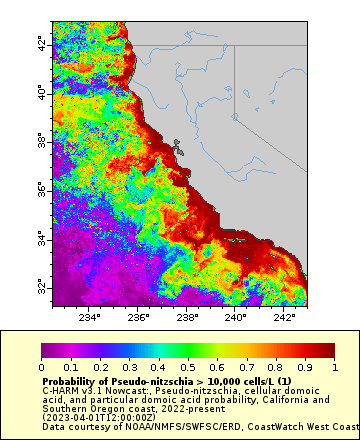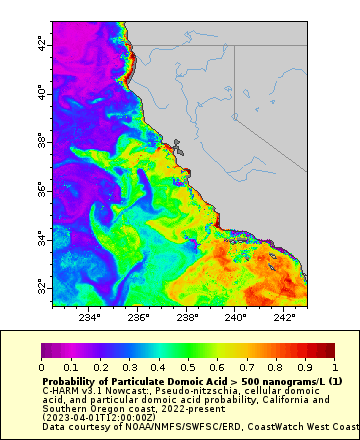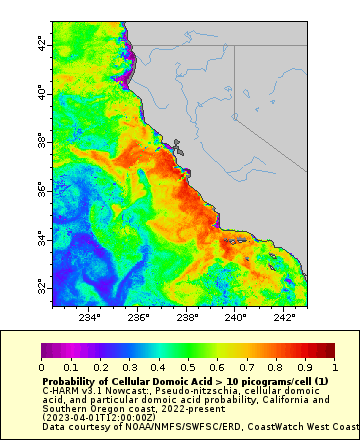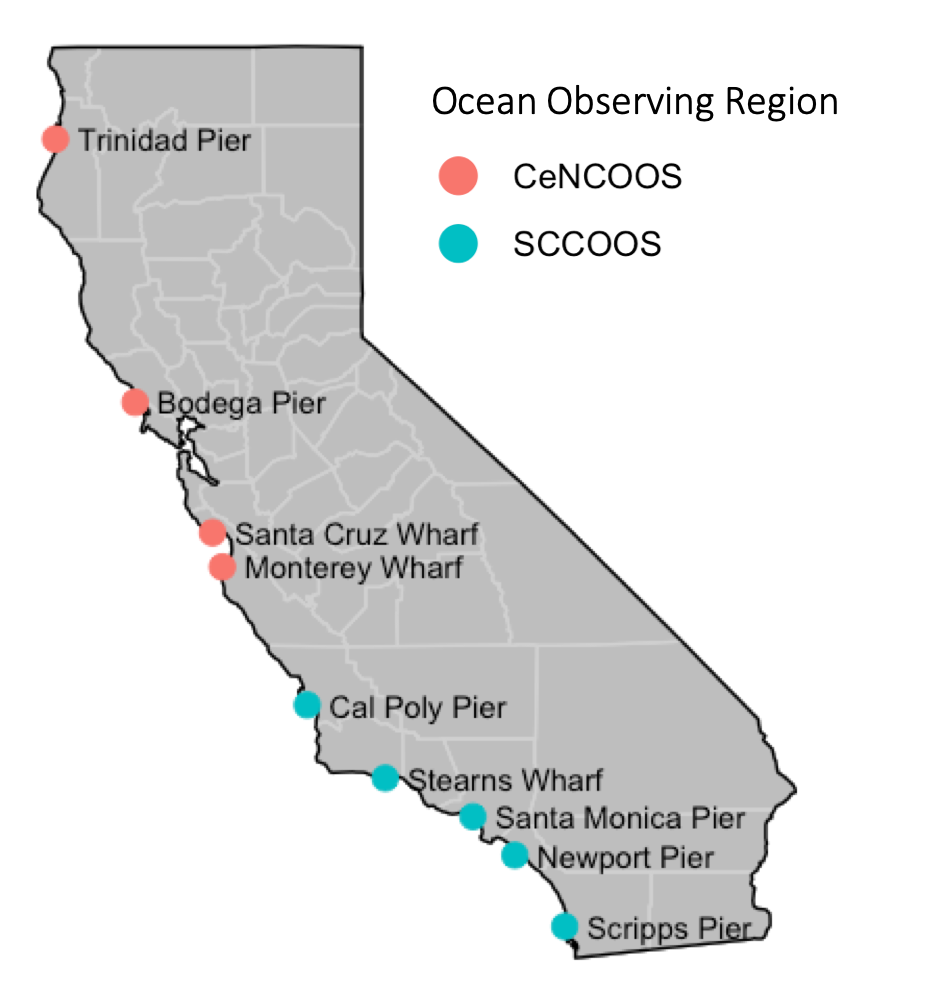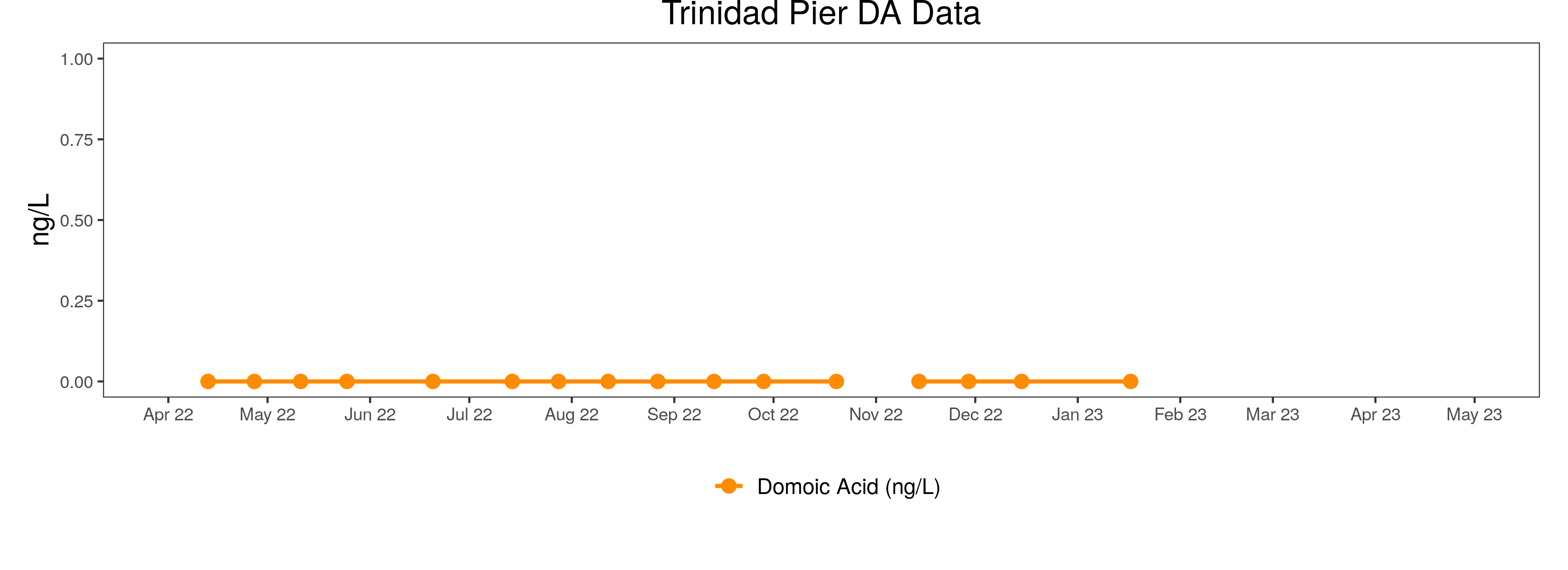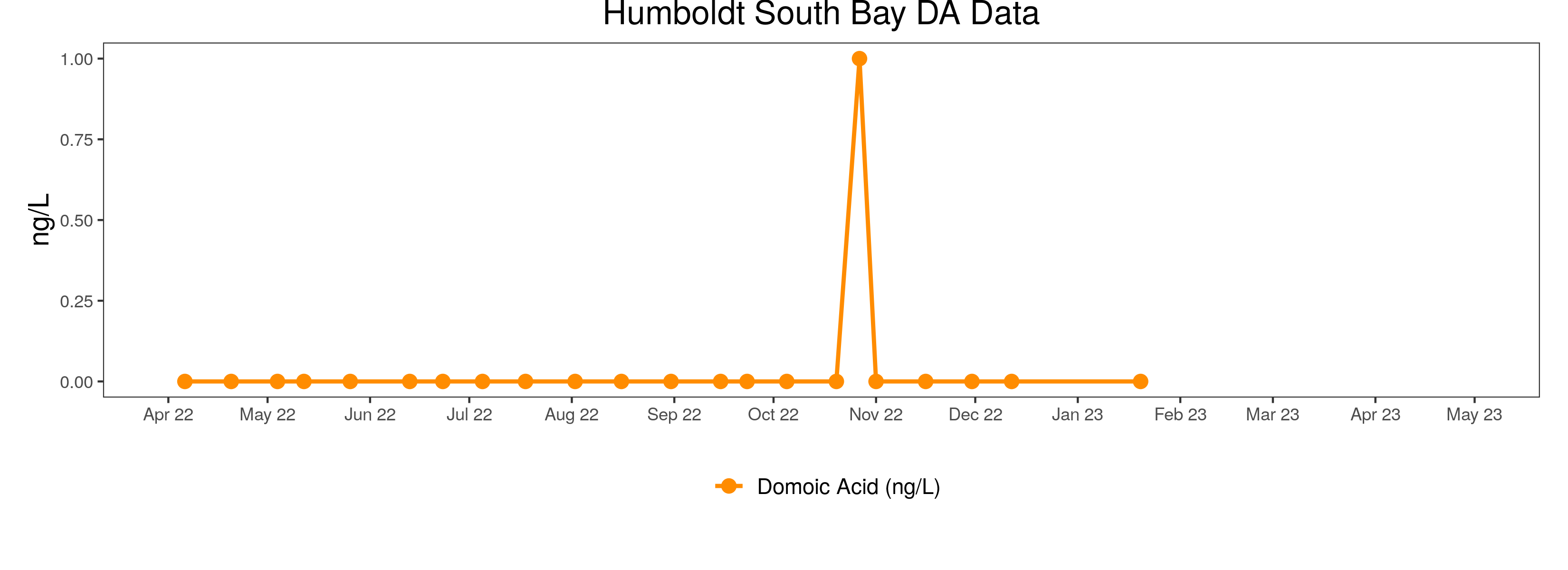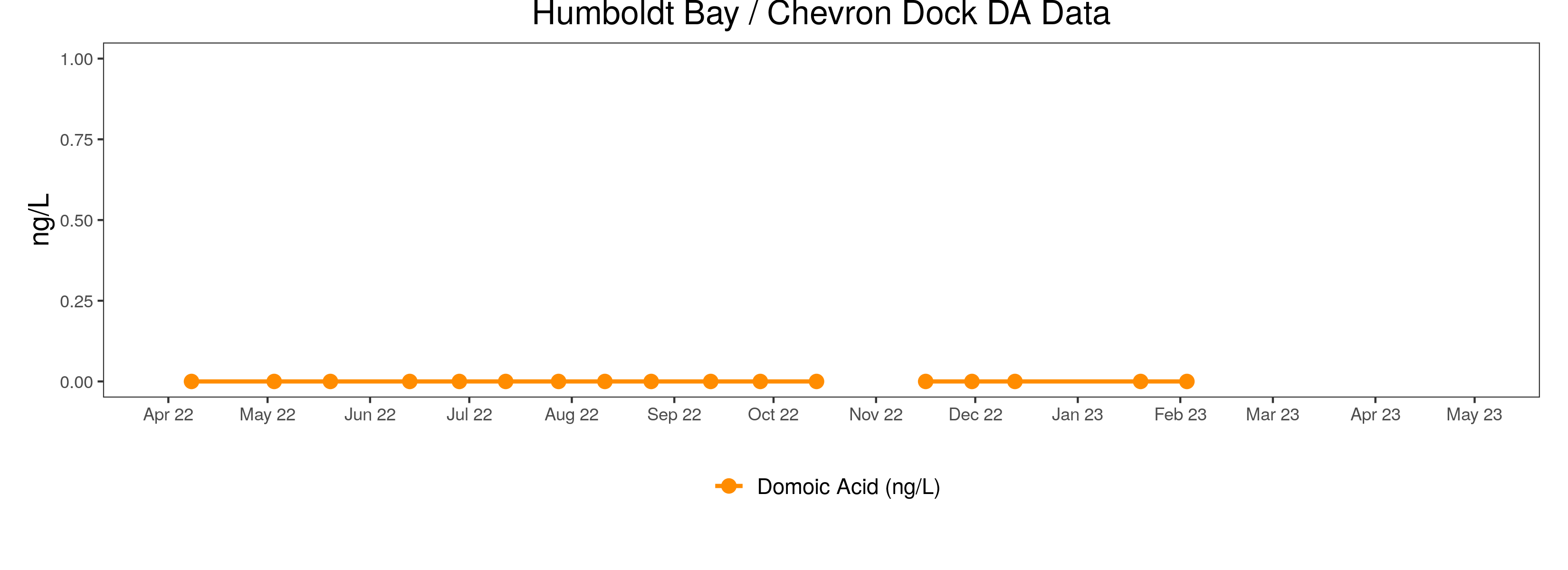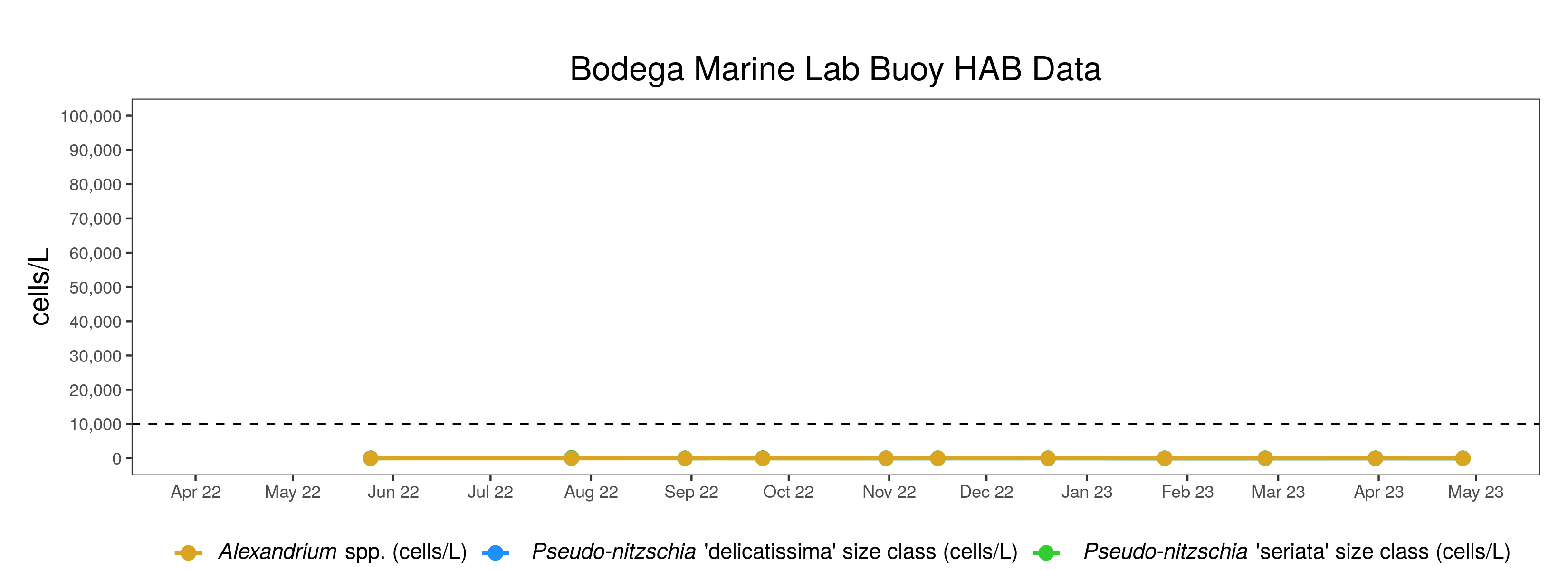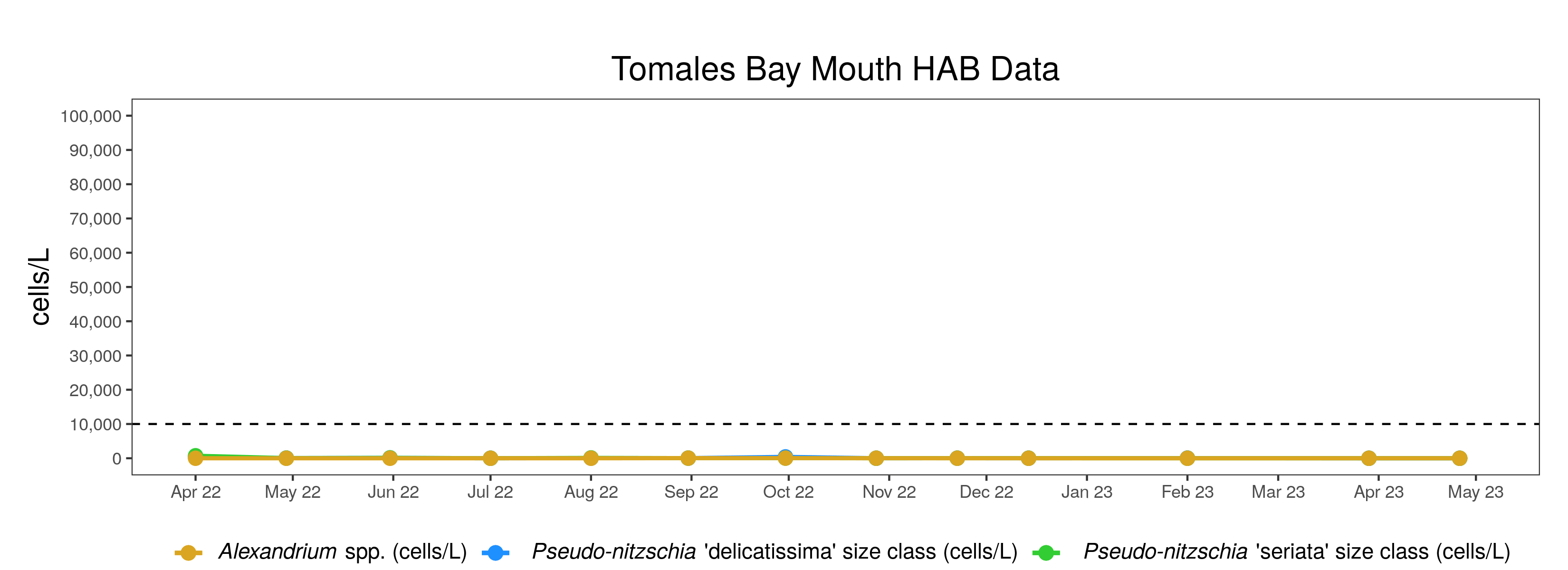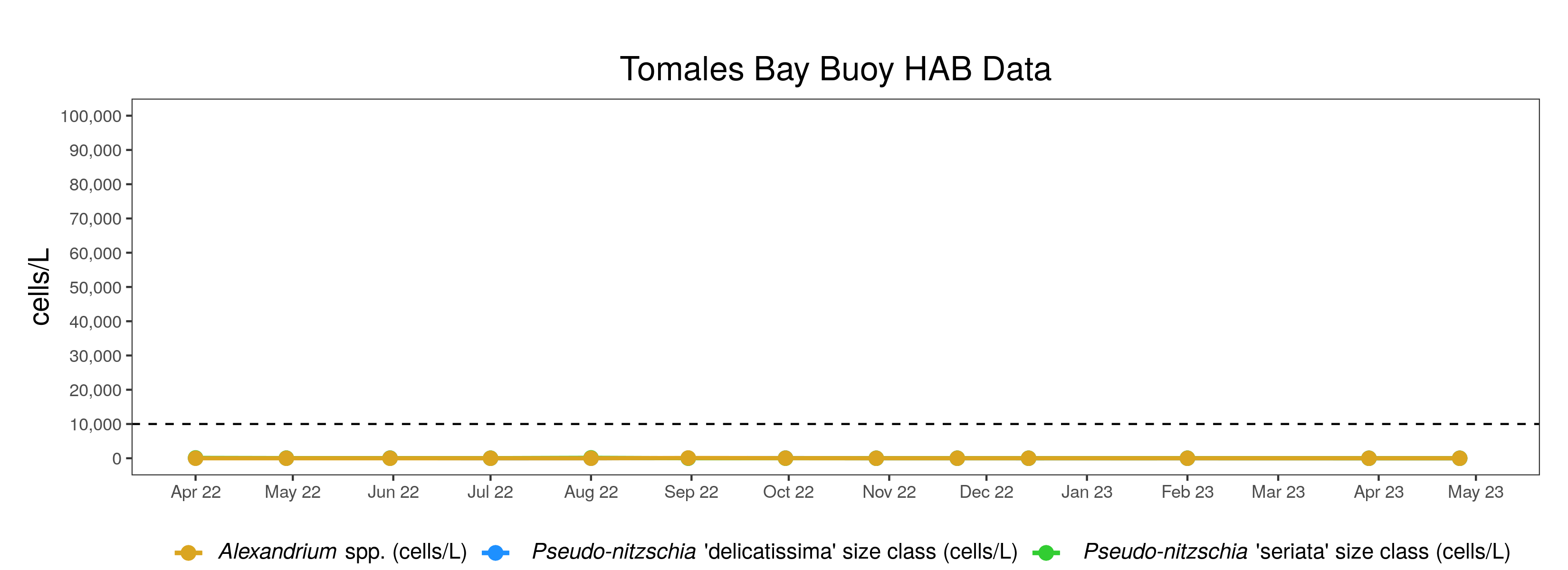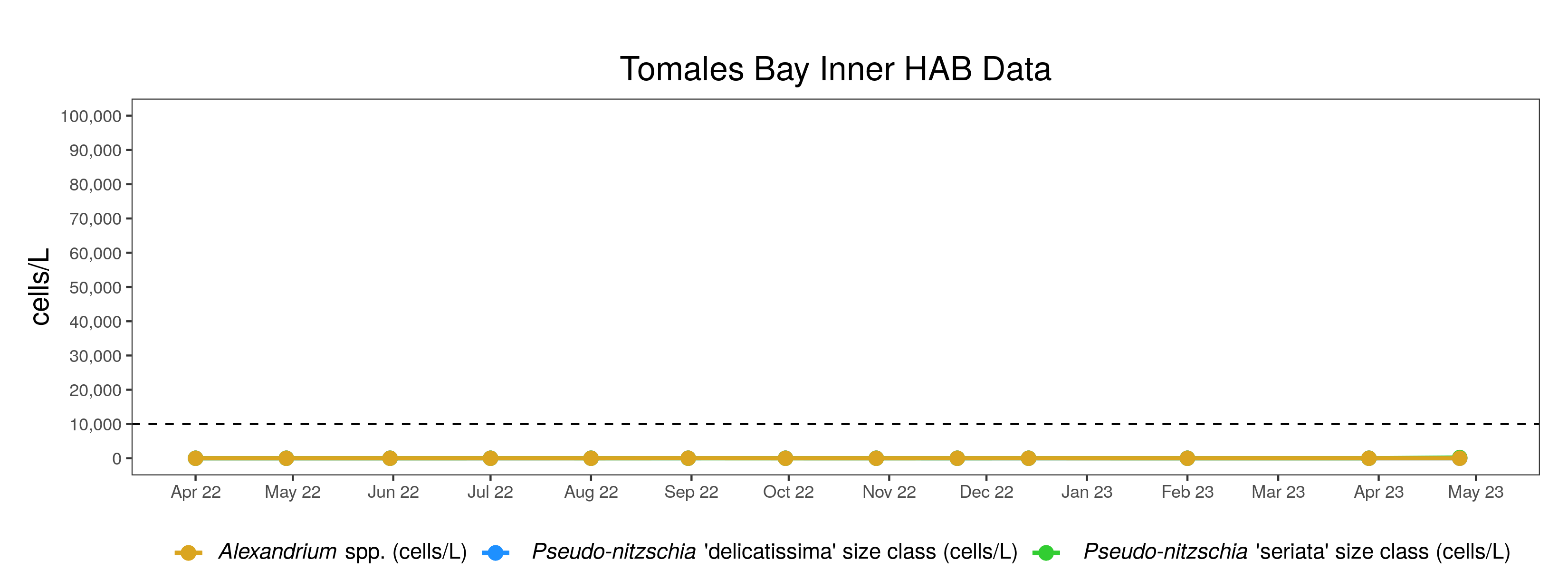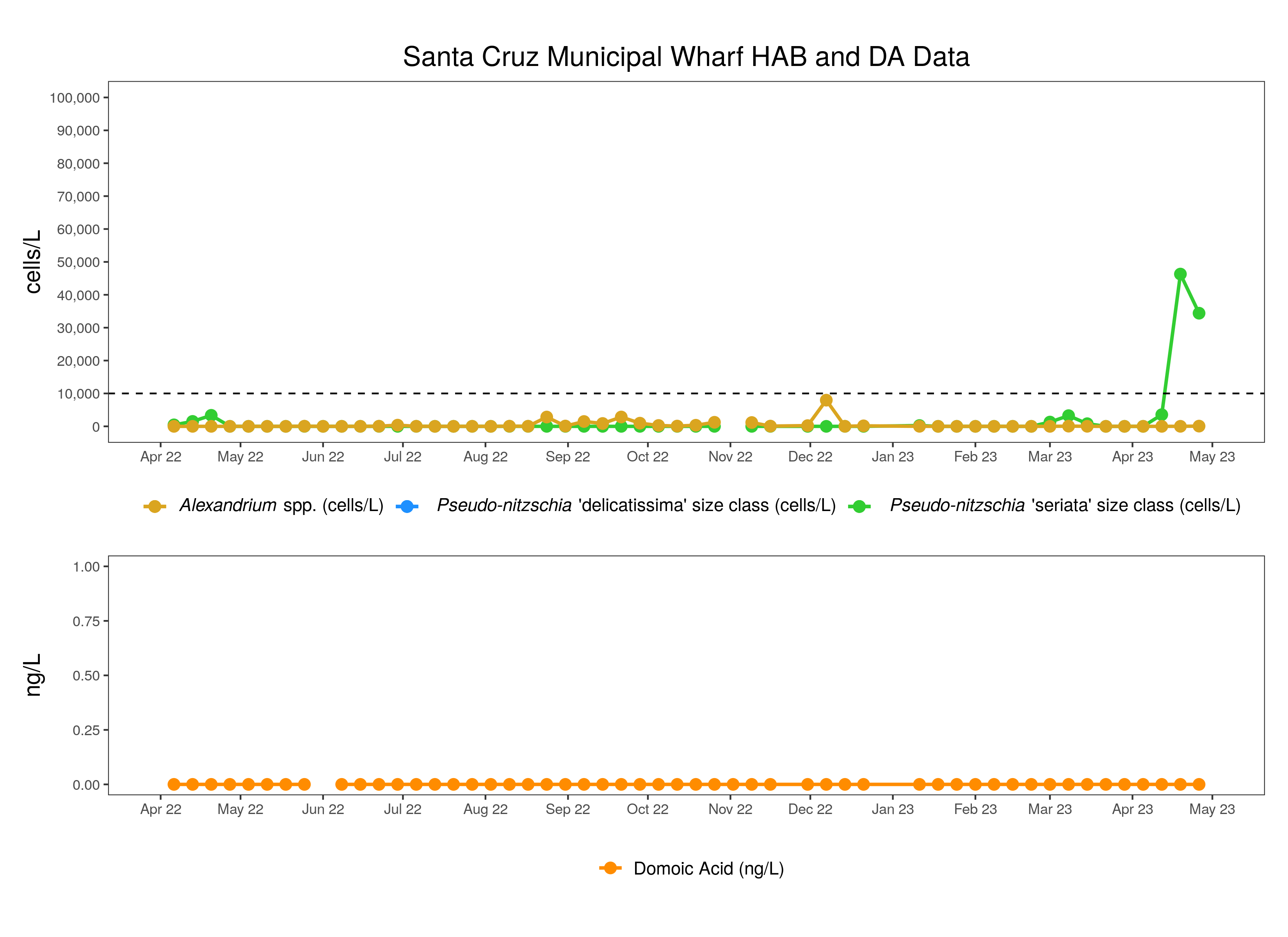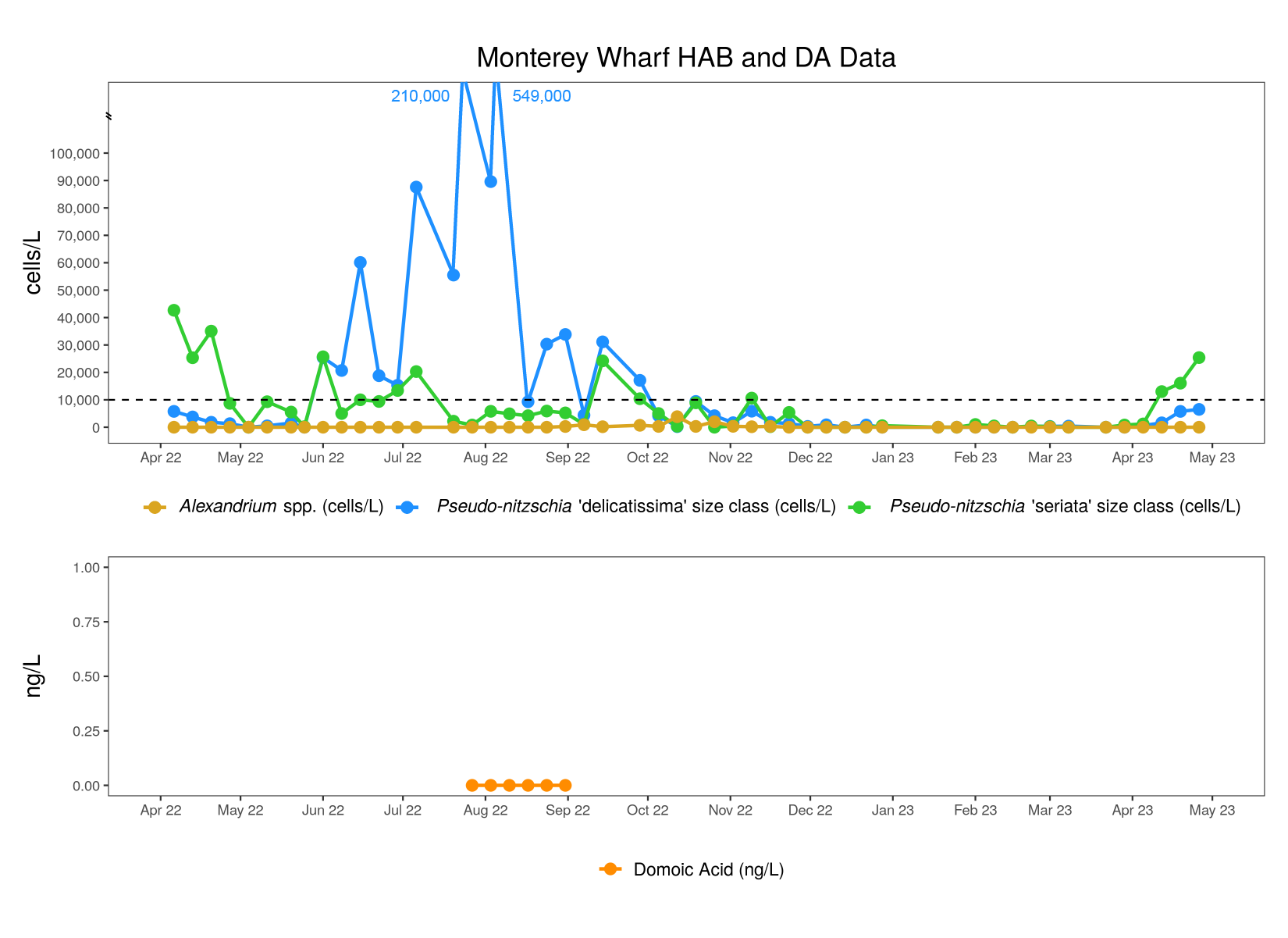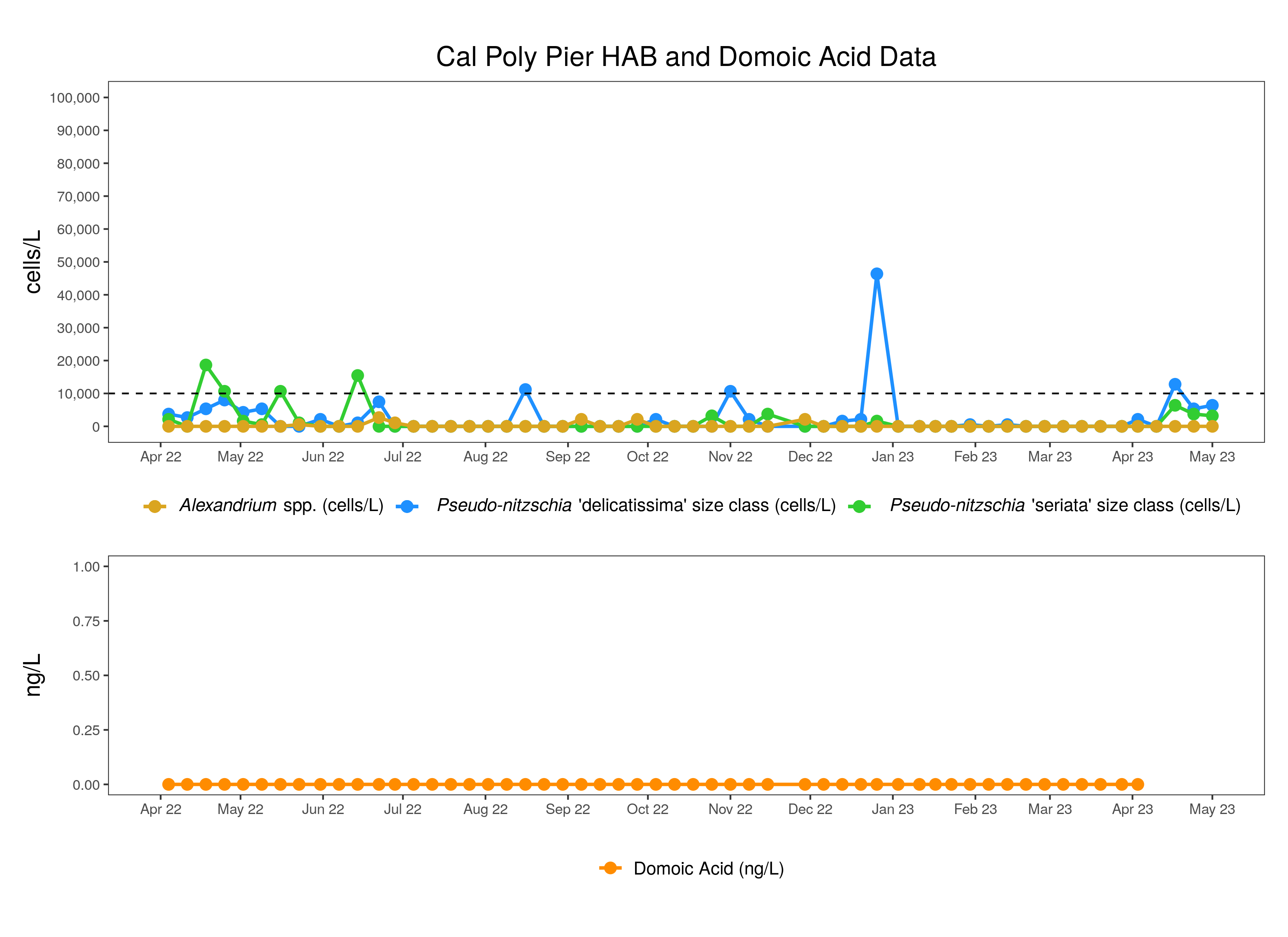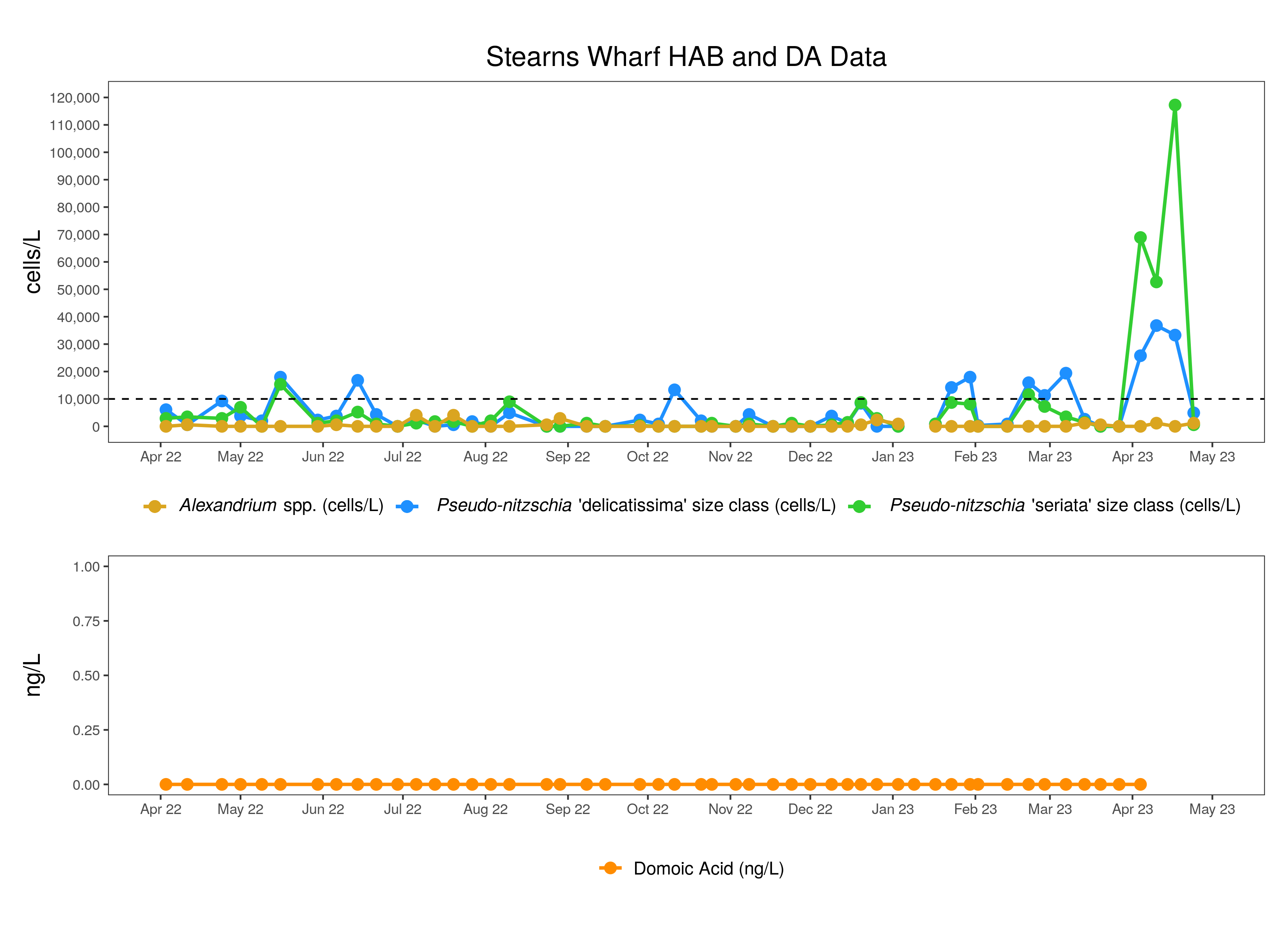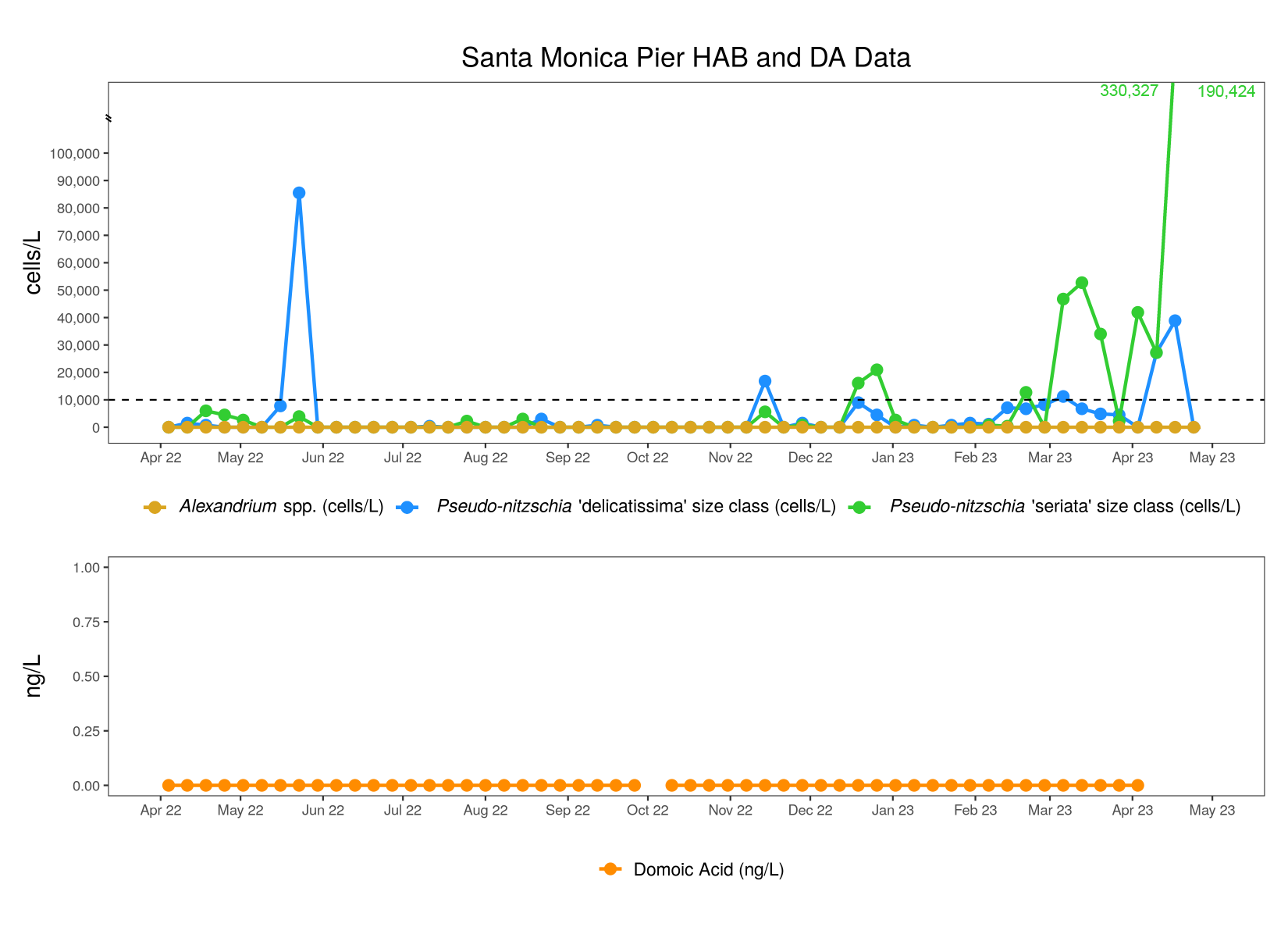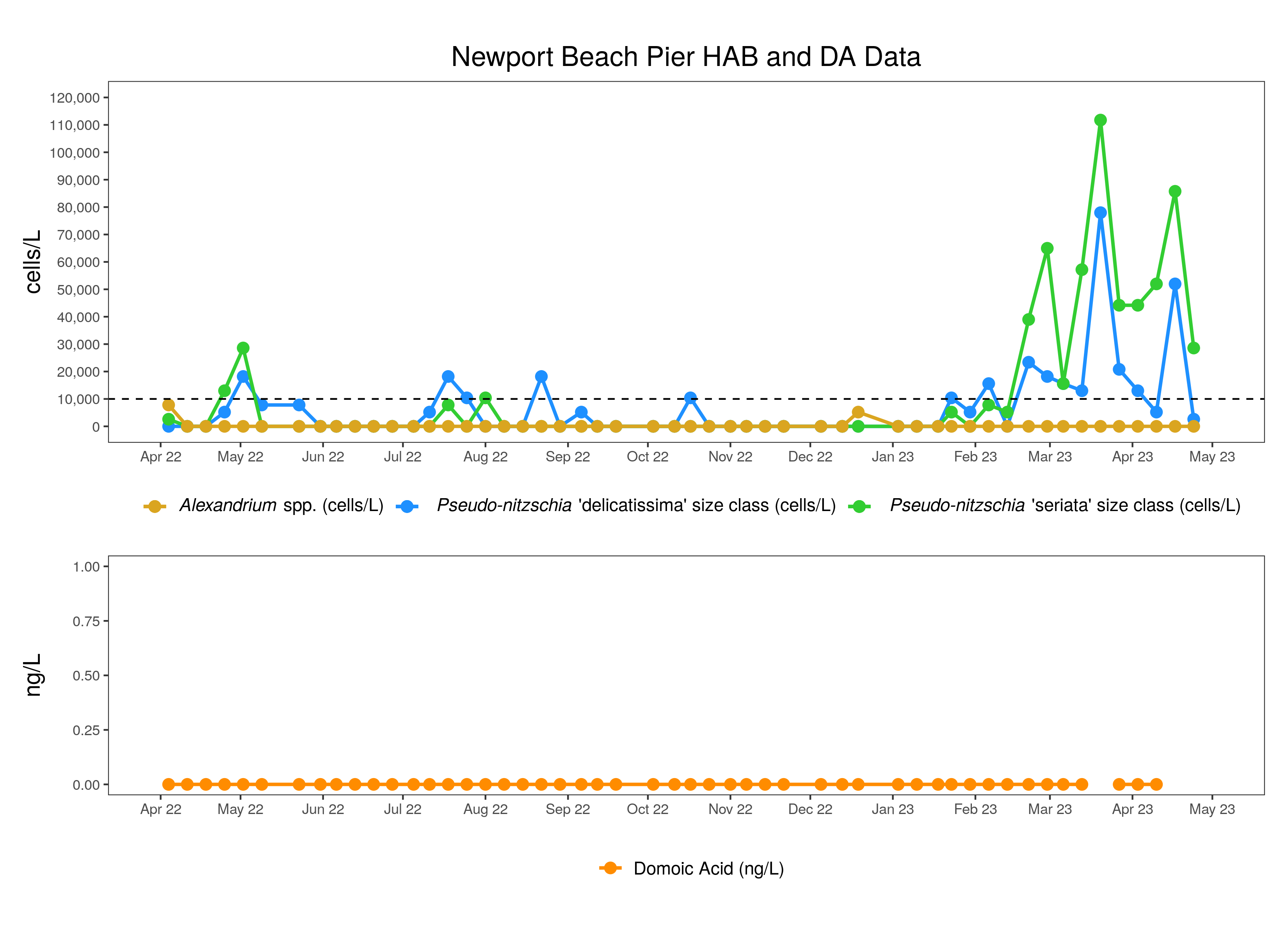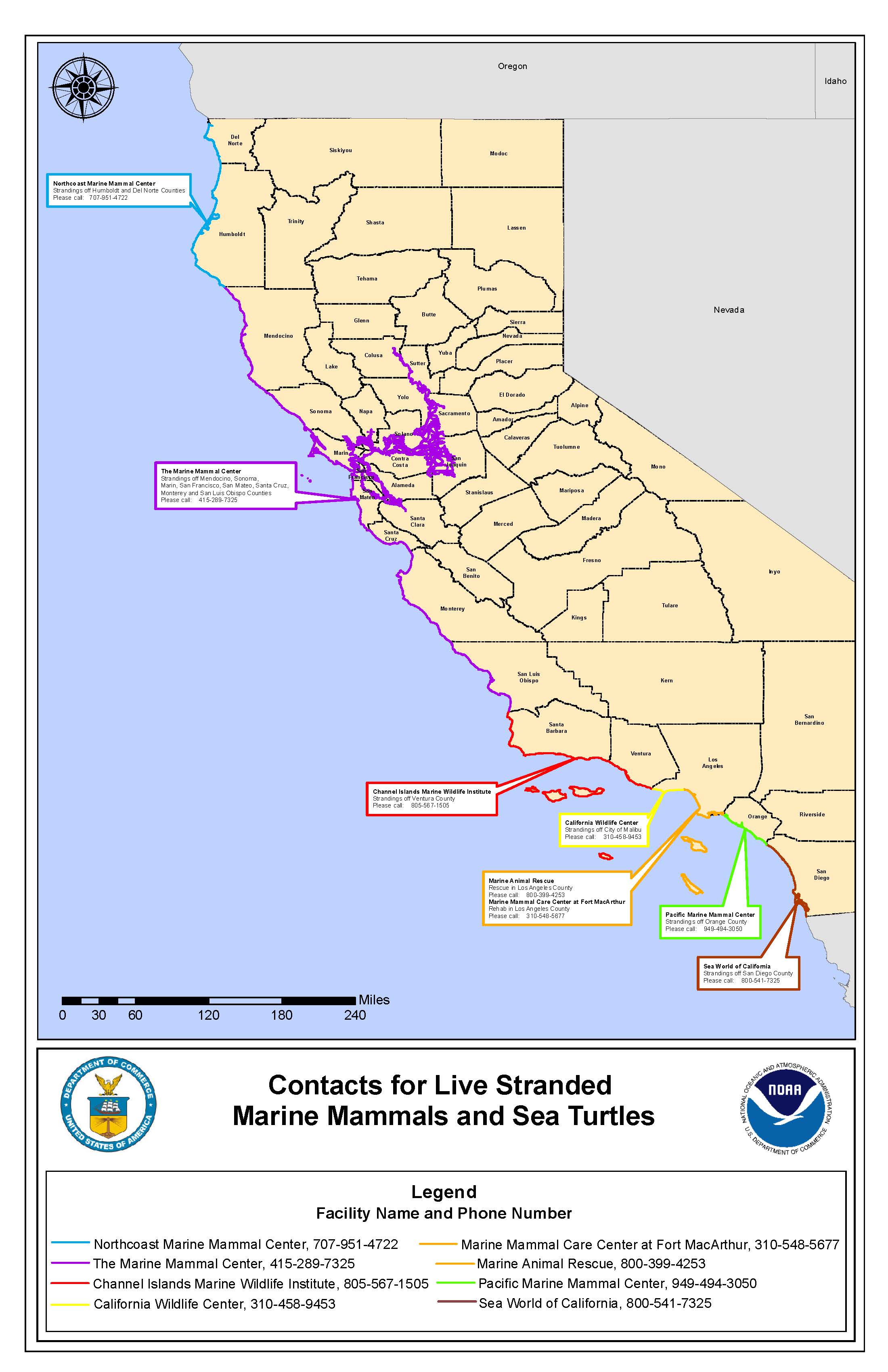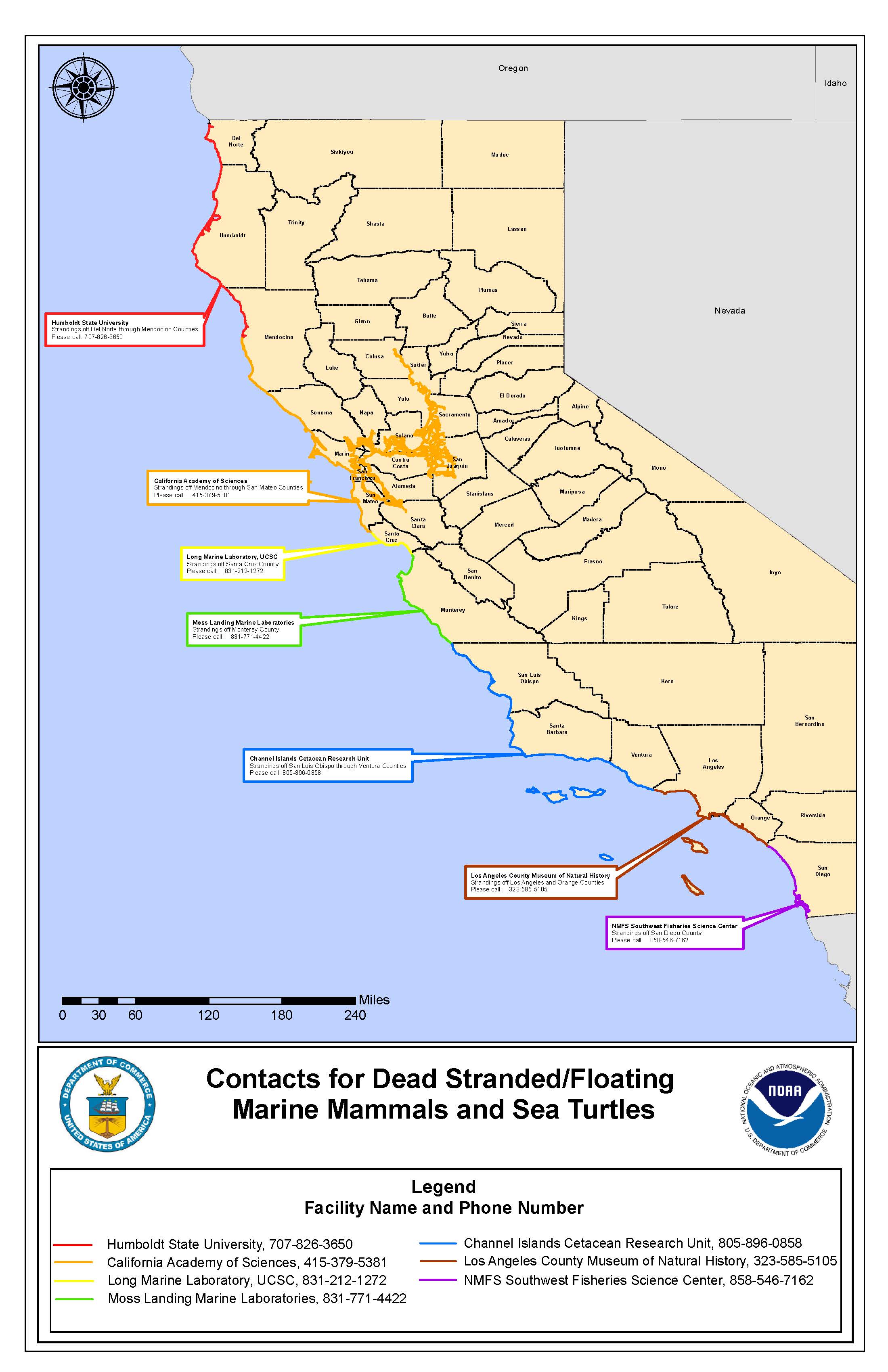APRIL HIGHLIGHTS
*note: for the full suite of HAB taxa sampled weekly, see the SCCOOS and CeNCOOS HABMAP database and the Imaging FlowCytobot Dashboard.
Pseudo-nitzschia -
* Important update to C-HARM in this bulletin. C-HARM version 3 is now operational at NOAA CoastWatch. Major changes include: new operational circulation model (WCOFS) for currents, salinity, and temperature and VIIRS ocean color products in place of MODIS Aqua. WCOFS is a 4DVAR data assimilative model run at NOAA Coast Survey Development Lab (CSDL). NOTE: There are serious issues with WCOFS salinity accuracy that have notable consequences for the Particulate Domoic Acid predictions; we will address the impact this has on pDA accuracy in these bulletins. Sensitivity analyses suggest that the impact of the shift to VIIRS for the ocean color inputs to C-HARM is small relative to the replacement of CA ROMS Classic with WCOFS (for salinity).
-
- C-HARM tells us where conditions are suitable for species of the diatom Pseudo-nitzschia spp. (all size classes) to grow well and where they might be more likely to produce the deadly neurotoxin, domoic acid (DA). Three independent models are run daily to produce nowcasts and three-day forecasts of the probability of a bloom, the probability of a DA event for particulate DA only, and the probability of a DA event for the cellular portion of DA only. Here, in the bulletin, we summarize nowcasts for the month.
- C-HARM predictions for Pseudo-nitzschia spp. blooms in April still contain quite a lot of pixelation from VIIRS, something we are working to fix. Bloom potential is extremely high throughout the month, covering much of the California Current. An emphasis earlier in the month is on higher risk along the central California coast with the full extent of the coastline and offshore region of the California Current showing high risk later in the month. The predictions for Pseudo-nitzschia corroborate something we've seen for a while in the California Current, which is that conditions are fairly regularly conducive to supporting Pseudo-nitzschia populations in most coastal zones.
- HABMAP weekly pier sampling indicates that April picked up where March left off with a lot of Pseudo-nitzschia spp. bloom activity from the Santa Cruz Wharf in central California down to Scripps Pier in southern California. Abundances were particularly high (>100,000 cells/L) from Stearns Wharf in Santa Barbara to Scripps Pier (San Diego Co.), particularly for the more toxigenic "seriata" size class, which bloomed at over 300,000 cells/L at Santa Monica Pier (Los Angeles) and over 250,000 cells/L at Scripps Pier.
- Pseudo-nitzschia activity from CDPH coastal sampling is consistent with a focus on southern California in April as we saw in March. 'Abundant' densities of the more toxigenic size class, Pseudo-nitzschia 'seriata,' were found at Catalina Island and again offshore at Crystal Cove in the Santa Barbara Channel Island region. 'Common' relative abundance values were found at sites distributed throughout southern California but also at Santa Cruz Wharf and 'Present' at sites throughout central and southern California.
- A selection of CA Imaging FlowCytobot (IFCB) Network images in April from seven sites throughout California is impressive in its community variability and shift in plankton diversity across a broad latitudinal gradient. An image time series at Scripps Pier in La Jolla captures a shift from dinoflagellates to a Pseudo-nitzschia bloom and back to a major "red tide" of Tripos and Prorocentrum spp. that garnered a lot of public attention due to the prolonged discoloration of the water in San Diego and throughout southern California area accompanied by low levels of bioluminescence at night. Pseudo-nitzschia spp. are quite evident in the Santa Cruz Wharf time series, aligning with HABMAP molecular probe sampling at that station in late April. Just offshore in Monterey Bay was a more mixed diatom assemblage. The SF Bay was dominated by single-celled centric diatoms and small flagellates as is often the case, and IFCBs at Bodega Bay and Hog Island Oyster Co. at Humboldt imaged beautiful arrays of chain-forming centric diatoms typical of a vibrant upwelling season.
- C-HARM probabilities for particulate domoic acid (pDA) and cellular domoic acid (cDA) place great emphasis on central and southern California throughout April. This corroborates the intense bloom activity in both regions even though DA never rose above zero at the pier sites where we currently have records for all of April (e.g. Santa Cruz Wharf).
- Interestingly, there are, as of yet, no animal stranding records associated with DA intoxication in April, which is inconsistent with the Pseudo-nitzschia 'seriata' activity nearshore at many stations and the C-HARM DA predictions. It may be that conditions were conducive to DA production, but there was a mismatch in timing or location of animal feeding relative to DA intensity. It may also be that the model overpredicted DA probabilities and that the nearshore DA outlook at the piers reflected what was happening offshore as well.
- CDPH lifted an advisory on January 9 for mussels, scallops, and most types of clams in Humboldt County due to PSP and ASP. However, the advisory related to sport-harvested razor clams from Humboldt and Del Norte counties seems to remain in effect due to ASP risk. Given the low depuration (detox) rates of razor clams, DA levels in razor clams are usually more a reflection of long-term exposure to DA rather than real-time or recent bloom conditions. However, since this same advisory was lifted in June and then reinstated in November of this year, there has likely been persistent, if low-level, production of DA in the North Coast region. Note that the annual quarantine for recreationally harvested mussels went into effect May 1.
Alexandrium -
- CDPH detected Alexandrium spp. at only 'Present' relative abundance levels at some sites in southern California in April, including at Scripps Pier where HABMAP sampling actually detected very high abundances of Alexandrium spp. (>250,000 cells/L) on April 10th. Interestingly, we did not see the same spike in images from the IFCB at Scripps Pier, perhaps aligning more with what CDPH measured at that site on the same day. No Paralytic Shellfish Poisoning (PSP) advisory ensured, and note that the PSP advisory in Humboldt County was lifted on January 9 for mussels, scallops, and most types of clams .
Summary written by Clarissa Anderson on 23 May 2023
Note that data for some stations are not shown because they are not yet recorded in the public HABMAP archive.
Differentiating Pseudo-nitzschia species by light microscopy is difficult. For this reason, Pseudo-nitzschia "seriata" does not refer to an actual species but rather the larger size class of Pseudo-nitzschia, which is generally a more toxigenic group of species. Alternatively, Pseudo-nitzschia "delicatissima" refers to the smaller size class that is generally non-toxigenic. The dashed line on the plots demarcates the 10,000 cells/L "bloom" threshold designated here for Pseudo-nitzschia populations only.
More information and data visualizations on the statewide HAB network and forecasting system can be found on the California HABMAP website and on the SCCOOS Harmful Algal Bloom page.
Five water samples were collected at the Bodega Marine Lab shore station in April. Pseudo-nitzschia "delicatissima" and Alexandrium spp. were not detected. Pseudo-nitzschia "seriata" was detected on two occasions (April 3, 10), below the threshold. Domoic acid results are pending.
The Bodega Marine Lab shore station is supported by CeNCOOS PI John Largier.
Four water samples were collected at Santa Cruz Wharf in April. Molecular probes for toxigenic Pseudo-nitzschia in the "seriata" class are conducted for this site, and was detected on three occasions (April 12, 19, 26) with the last two detections above the bloom threshold. Alexandrium spp. were detected on April 19 and 26. Domoic acid was not detected.
The Santa Cruz Wharf shore station is supported by CeNCOOS PI Raphael Kudela at UCSC
Four water samples were collected at Monterey Wharf in April. Pseudo-nitzschia "delicatissima" was detected on each occasion (April 5, 12, 19, 26) below the bloom threshold. Pseudo-nitzschia "seriata" was also detected each time, with April 12, 19, and 26 above the threshold. Alexandrium spp. were not detected. Domoic acid results are pending.
Monterey Wharf shore station is supported by CeNCOOS.
Four water samples were collected at Cal Poly Pier in April. Pseudo-nitzschia "delicatissima" was detected three times (April 3, 17, 24), with April 17 above the bloom threshold. Pseudo-nitzschia "seriata" was detected twice (April 17, 24) below the threshold. Alexandrium spp., were not detected and domoic acid results are pending.
Cal Poly Pier shore station is supported by SCCOOS and PI Ally Pasulka at Cal Poly.
Four water samples were collected at Stearns Wharf in April. Pseudo-nitzschia "delicatissima" and Pseudo-nitzschia "seriata" were detected on each occasion (April 4, 10, 17, 24), all above the bloom threshold except for the last samples. Alexandrium spp. were detected on April 10 and April 24. Domoic acid was not detected in the first sample with the remaining results pending.
Stearns Wharf is supported by SCCOOS and PIs Mark Brzezinski and Libe Washburn at UCSB.
Four water samples were collected at Santa Monica Pier in April. Pseudo-nitzschia "delicatissima" was detected twice (April 10, 17) above the bloom threshold. Pseudo-nitzschia "seriata" was detected on each occasion (April 3, 10, 17, 24) above the threshold. Alexandrium spp. were not detected. Domoic acid was not detected in the first sample with the remaining pending analysis.
The Santa Monica Pier shore station is supported by SCCOOS and PI Rebecca Shipe at UCLA.
Four water samples were collected at Newport Beach Pier in April. Pseudo-nitzschia "delicatissima" and Pseudo-nitzschia "seriata" were detected on each occasion (April 3, 10, 17, 24), all above the bloom threshold except for Pseudo-nitzschia "delicatissima" on April 10, 24. Alexandrium spp. were not detected. Domoic acid was not detected in the first two samples with the remaining pending analysis.
Newport Beach Pier is supported by SCCOOS and PI David Caron at USC.
Four water samples were collected at Scripps Pier in April. Pseudo-nitzschia "delicatissima" was detected twice (April 17, 24), with the first above the bloom threshold. Pseudo-nitzschia "seriata" was detected on three occasions (April 10, 17, 24), all above the bloom threshold. Alexandrium spp. were detected on 3 occasions (April 10, 17, 24). Domoic acid was not detected in the first sample with the remaining results pending.
Scripps Pier is supported by SCCOOS and PIs Melissa Carter and Clarissa Anderson at UCSD.
CDPH observations for Pseudo-nitzschia "seriata" and Alexandrium spp.
View the interactive map and data table of California Department of Public Health (CDPH) data from January 2019 to present, developed by SCCOOS, below. Or, view CDPH Toxic Phytoplankton Observations Map with layers of Pseudo-nitzschia and Alexandrium spp. as well as other phytoplankton species observations (in the pop-up windows).
Data are provided by the Environmental Management Branch of the CDPH. Please note, starting in July 2019, CDPH moved to only reporting Pseudo-nitzschia of the seriata complex and not all Pseudo-nitzschia spp. as previously provided.
Please email CDPH at Thomas.Hayashi@cdph.ca.gov for any potential marine HAB-related illness in humans.
From April 1-30 2023, water samples were collected by volunteers and sent to the California Department of Public Health (CDPH) for analysis.
Pseudo-nitzchia "seriata" group was detected in 60 of the 90 samples:
Pseudo-nitzschia "seriata" was detected at "Abundant" density levels on 2 occasions:
- 2023-04-15 50% Catalina Island, Avalon Bay
- 2023-04-17 60% Crystal Cove SB, OFFSHORE
Pseudo-nitzschia "seriata" was detected at "Common" density levels on 21 occasions:
- 2023-04-01 25% Catalina Island, Avalon Bay
- 2023-04-02 20% Palos Verdes, OFFSHORE
- 2023-04-04 15% San Clemente Pier
- 2023-04-05 20% Catalina Island, Toyon Bay
- 2023-04-06 10% Imperial Beach Pier
- 2023-04-06 25% Santa Monica Pier
- 2023-04-08 25% Palos Verdes, OFFSHORE
- 2023-04-11 12% Manhattan Beach Pier
- 2023-04-11 14% Goleta Pier
- 2023-04-13 20% Imperial Beach Pier
- 2023-04-14 25.5% Bolsa Chica
- 2023-04-15 20% Catalina Island, Avalon Bay
- 2023-04-16 20% Pacific Beach Pier
- 2023-04-17 10% Santa Barbara Harbor
- 2023-04-17 20% Santa Barbara Harbor
- 2023-04-18 30% Goleta Pier
- 2023-04-19 18% Santa Monica Pier
- 2023-04-22 15% Point Dume, offshore
- 2023-04-22 33% Palos Verdes, OFFSHORE
- 2023-04-26 25% Santa Cruz Wharf
- 2023-04-27 20% Santa Barbara, Mohawk Reef
Pseudo-nitzschia "seriata" was detected at "Present" density levels on 20 occasions:
- 2023-04-03 1% La Jolla, Scripps Pier
- 2023-04-07 2% Bolsa Chica
- 2023-04-11 8% Catalina Island, Avalon Bay
- 2023-04-12 2% Santa Cruz Wharf
- 2023-04-13 5% San Diego Bay, U.S. Navy Pier
- 2023-04-16 5% San Simeon Pier
- 2023-04-17 1% Morro Bay, Boat Launch
- 2023-04-17 1% La Jolla, Scripps Pier
- 2023-04-17 3% Imperial Beach Pier
- 2023-04-18 4% Monterey Bay, Commercial Wharf
- 2023-04-19 3% Santa Cruz Wharf
- 2023-04-19 6% San Diego Bay, U.S. Navy Pier
- 2023-04-20 4% Port San Luis, Diablo Cove
- 2023-04-21 5% Santa Monica Pier
- 2023-04-22 5% San Simeon Pier
- 2023-04-24 3% Morro Bay, Boat Launch
- 2023-04-24 6% Monterey Bay, Commercial Wharf
- 2023-04-26 3% Imperial Beach Pier
- 2023-04-27 2% Port San Luis, Diablo Cove
- 2023-04-27 2% San Clemente Pier
Pseudo-nitzschia "seriata" was detected at "Rare" density levels on 17 occasions:
- 2023-04-02 0.5% Monterey Bay, Commercial Wharf
- 2023-04-03 0.5% Morro Bay, Boat Launch
- 2023-04-04 0.5% Tomales Bay, Lease #M430-15
- 2023-04-05 0.5% Santa Cruz, Capitola Pier
- 2023-04-06 0.5% San Diego Bay, U.S. Navy Pier
- 2023-04-09 0.5% Morro Bay, North T-Pier
- 2023-04-10 0.5% Morro Bay, Boat Launch
- 2023-04-11 0.5% Pillar Point Harbor
- 2023-04-12 0.5% Richmond, Marina Bay Harbor
- 2023-04-15 0.5% Catalina Island, OFFSHORE
- 2023-04-17 0.5% Tomales Bay, Lease #M430-15
- 2023-04-21 0.5% Bolsa Chica
- 2023-04-24 0.5% Humboldt Bay, Indian Is. Ch.
- 2023-04-24 0.5% Wilson Creek
- 2023-04-26 0.5% Goleta Pier
- 2023-04-27 0.5% San Diego Bay, U.S. Navy Pier
- 2023-04-28 0.5% Hunter Rock, north
Alexandrium spp. were detected in 15 of the 90 samples:
Alexandrium spp. were not detected at "Common" density levels.
Alexandrium spp. were detected at "Present" density levels on 2 occasions.
- 2023-04-10 1% La Jolla, Scripps Pier
- 2023-04-13 1% San Diego Bay, U.S. Navy Pier
Alexandrium spp. were detected at "Rare" density levels on 13 occasions:
- 2023-04-02 0.5% Monterey Bay, Commercial Wharf
- 2023-04-04 0.5% San Clemente Pier
- 2023-04-06 0.5% Santa Monica Pier
- 2023-04-11 0.5% Manhattan Beach Pier
- 2023-04-11 0.5% Goleta Pier
- 2023-04-13 0.5% Imperial Beach Pier
- 2023-04-17 0.5% Santa Barbara Harbor
- 2023-04-18 0.5% Monterey Bay, Commercial Wharf
- 2023-04-18 0.5% Goleta Pier
- 2023-04-21 0.5% Bolsa Chica
- 2023-04-26 0.5% Goleta Pier
- 2023-04-26 0.5% Imperial Beach Pier
- 2023-04-27 0.5% Santa Barbara, Mohawk Reef
CDPH and OEHHA Health Advisories
May 1. The California Department of Public Health (CDPH) today announced the annual quarantine of sport-harvested mussels gathered along the California coast.
January 9. The California Department of Public Health (CDPH) has lifted the shellfish safety notification today related to sport-harvested mussels, scallops, and most types of clams in Humboldt County. An advisory for razor clams in Humboldt County remains in effect.
December 12. The California Department of Public Health (CDPH) has lifted the shellfish safety notifications today related to sport-harvested mussels, scallops, and clams in San Mateo, Monterey, and San Luis Obispo counties.
October 31. The California Department of Public Health (CDPH) announced the statewide annual quarantine on mussels taken by sport harvesters from California’s ocean waters ends at midnight on Monday, October 31, 2022, for all coastal counties except Humboldt, San Mateo, Monterey, and San Luis Obispo.
For the latest closures and updates, please visit the CDPH Health Advisories page as a central location of information related to CDPH health advisories. Also available is a map showing the current CDPH Recreational Bivalve Shellfish Advisories (see below).
The HAB-related illness workgroup has developed a new webpage and factsheet for marine HAB-related illness tracking in English and Spanish versions.
A network of Imaging FlowCytobots (IFCBs) continuously photographs particles, such as plankton, in the water. Using machine learning, plankton species can be automatically identified. This will help improve the ability to detect and respond to Harmful Algal Blooms, including the ability to assess conditions that may lead to toxin production or blooms of toxin-producing algae.
Additional images and data are available on the IFCB dashboard.
A mosaic of IFCB images from April.
Domoic acid (DA) is a potent neurotoxin produced by some diatom species of the genus Pseudo-nitzschia. Species exposed to DA can result in seizures, epilepsy, cardiomyopathy, and death depending upon the ingested dose. DA toxicosis commonly occurs in California Sea Lions (Zalophus californianus), presumably due to a combination of foraging behavior and seasonal movements. The Marine Mammal Center (TMMC), Channel Islands Marine Wildlife Institute (CIMWI), California Wildlife Center (CWC), Marine Mammal Care Center Los Angeles (MMCC-LA), Marine Animal Rescue (MAR), the Pacific Marine Mammal Center (PMMC), SeaWorld, and Southwest Fisheries Science Center (SWFSC) act like an emergency room by working to rescue and rehabilitate sick and injured marine mammals, seabirds, and sea turtles.
CIMWI, PMMC, MMCCLA, CWC, TMMC and SeaWorld did not record any strandings due to suspected domoic acid in April 2023.

